
DIpil Das
US
| What’s New? | Trend Data | Positive or Negative* |
| Earnings vs. Inflation: In February, the US saw another four-decade high in inflation. Consumer prices increased 7.9% compared to a year ago, with inflation at its highest point since 1982. Inflation is being led by volatile gas prices, rising energy costs and food price increases. Meanwhile, average weekly earnings growth picked up pace in February owing to another strong month of job creation. Year-over-year, average weekly earnings grew 5.4% in February. Inflation continues to outpace average earnings growth in the US, cutting into consumers’ ability to spend. |
Average Weekly Earnings vs. Consumer Prices: YoY % Change [caption id="attachment_144457" align="aligncenter" width="300"]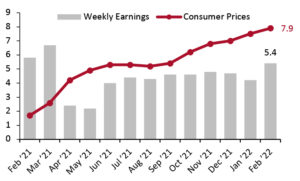 Data are not seasonally adjusted[/caption] Data are not seasonally adjusted[/caption] |
|
| Food and Fuel Prices: Food and gas price inflation rates are significant metrics because higher costs in these categories can impact discretionary spending. February saw US food inflation continue to climb, as prices rose 8.6% from a year ago, up from January’s 7.4% year-over-year growth. Food price inflation is being driven, in part, by skyrocketing gas prices. The US saw the price of all types of gasoline rise 38.0% in February. While it appears gas prices had begun to ease, recent geopolitical developments have put even further upward pressure on gas prices in March. |
Consumer Prices for Food at Home and Gasoline: YoY % Change [caption id="attachment_144458" align="aligncenter" width="300"]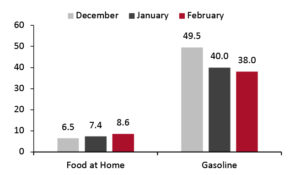 Data are not seasonally adjusted[/caption] Data are not seasonally adjusted[/caption] |
|
| Retail Sales: Total US retail sales, excluding gasoline and automobiles, grew by a very strong 12.8% year over year, fueled by inflation and a real-terms uplift. |
Total Retail Sales ex. Automobiles and Gasoline: YoY % Change [caption id="attachment_144459" align="aligncenter" width="300"]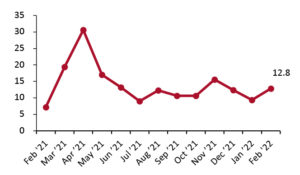 Data are not seasonally adjusted[/caption] Data are not seasonally adjusted[/caption] |
UK
| What’s New? | Trend Data | Positive or Negative* |
| Earnings vs. Inflation: In the UK, inflation continued its steady upward trend. Consumer prices grew 5.5% from a year ago. With inflation continuing to move upward, average weekly earnings growth has fallen behind the rise in consumer prices. Average weekly earnings growth grew 4.9% in January (latest available data) and is now underpacing inflation, a negative for consumer spending abilities. |
Average Weekly Earnings vs. Consumer Prices: YoY % Change [caption id="attachment_144460" align="aligncenter" width="300"]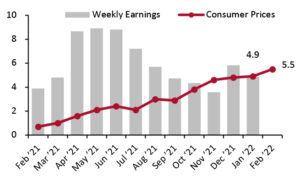 Latest earnings data are for January; consumer prices are CPIH[/caption] Latest earnings data are for January; consumer prices are CPIH[/caption] |
|
| Food and Fuel Prices: As previously stated, higher costs for food and automotive fuel can impact discretionary spending. In January, UK food price inflation continued its steady upward trend, rising to 5.1%, up from January’s 4.4% year-over-year growth. However, automotive fuel price inflation has been easing. In February, automotive fuel prices rose 22.3% from the prior year, compared to January’s 23.6%. Still, the effects of the conflict in Ukraine are likely to result in upward pressure on automotive fuel prices in March. |
Consumer Prices for Food at Home and Automotive Fuel: YoY % Change [caption id="attachment_144461" align="aligncenter" width="300"]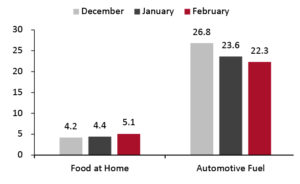 Data are not seasonally adjusted[/caption] Data are not seasonally adjusted[/caption] |
|
| Retail Sales: Total UK retail sales growth remained strong in February, growing 10.0% from the previous year. Sales volumes lost momentum, growing just 3.5% from the prior year. On a month-over-month basis, sales volumes declined by 0.3%, reflecting the impact of rising prices on consumer spending. |
Total Retail Sales ex. Automobiles and Automotive Fuel: YoY % Change [caption id="attachment_144462" align="aligncenter" width="300"]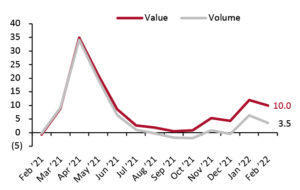 Data are not seasonally adjusted[/caption] Data are not seasonally adjusted[/caption] |
|
China
| What’s New? | Trend Data | Positive or Negative* |
| Income vs. Inflation: In China, the consumer price index growth stayed in line with January’s, with prices growing just 0.9% from the prior year. Data on per capita disposable income are released quarterly. In the fourth quarter of 2021, per capita disposable income grew 5.4% year over year, down from the 10.4% growth in the third quarter of 2021 but remaining healthy. Growth in disposable income is outpacing increases in consumer prices, a net positive for consumers’ ability to spend. |
Per Capita Disposable Income vs. Consumer Prices: YoY % Change [caption id="attachment_144463" align="aligncenter" width="300"]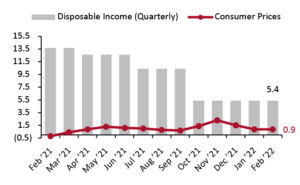 Disposable income data are quarterly[/caption] Disposable income data are quarterly[/caption] |
|
| Food and Fuel Prices: As previously stated, higher costs for food and automotive fuel can impact discretionary spending. In February, food price deflation picked up. Food prices declined 1.8% from a year ago. Meanwhile, automotive fuel price inflation continued to accelerate, growing 37.2% year over year. |
Consumer Prices for Food at Home and Automotive Fuel: YoY % Change 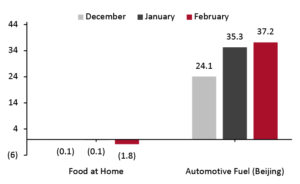 |
|
| Retail Sales: Retail sales data for January and February are released together in March. Total retail sales in China increased 6.5% year over year in January and February. We suspect the latest retail sales data was boosted by the Chinese New Year period and the Winter Olympics. Thus, any boost to sales from these factors is likely concealing soft underlying retail demand in China. |
Total Retail Sales ex. Food Service, incl. Automobiles and Gasoline: YoY % Change [caption id="attachment_144464" align="aligncenter" width="300"]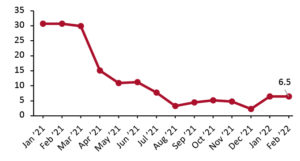 From December 2020, our China retail sales index excludes food-service sales; data in prior reports included food-service sales. Data for January and February 2021 are aggregated.[/caption] From December 2020, our China retail sales index excludes food-service sales; data in prior reports included food-service sales. Data for January and February 2021 are aggregated.[/caption] |